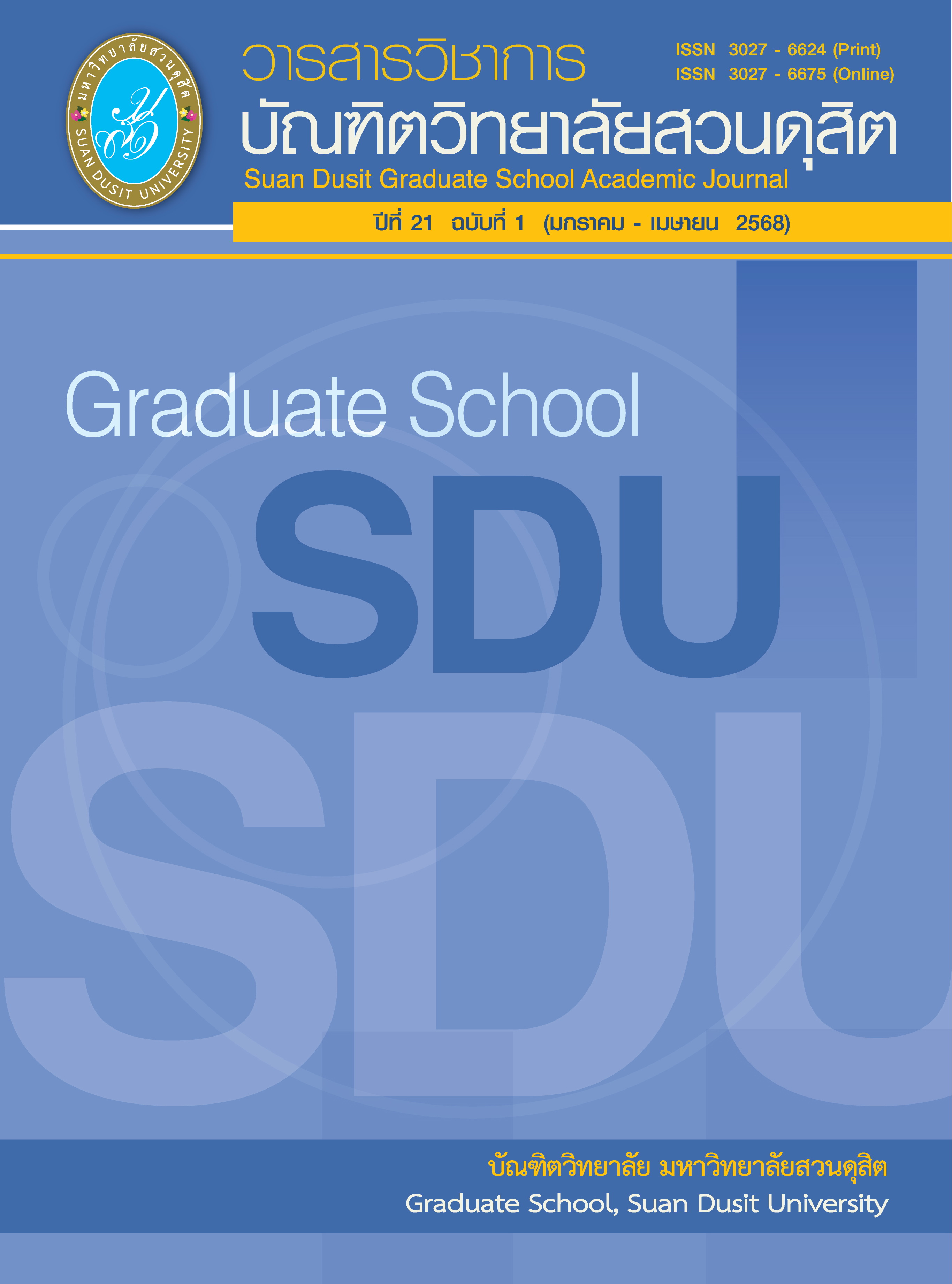Sirote's Model for University Quality Integration: ต้นแบบการบูรณาการศาสตร์และศิลป์ในการบริหารสถาบันอุดมศึกษา
คำสำคัญ:
Sirote's Model, การบริหารสถาบันอุดมศึกษา, การบริหารคุณภาพเชิงบูรณาการบทคัดย่อ
บทความนี้นำเสนอ Sirote's Model for University Quality Integration ซึ่งเป็นแนวทางการบริหารที่บูรณาการศาสตร์การบริหารจัดการสมัยใหม่เข้ากับภูมิปัญญาและวัฒนธรรมไทย พัฒนาขึ้นจากการถอดบทเรียนการบริหารของรองศาสตราจารย์ ดร.ศิโรจน์ ผลพันธิน อดีตอธิการบดีมหาวิทยาลัยสวนดุสิต ผู้นำที่ประสบความสำเร็จในการปรับเปลี่ยนมหาวิทยาลัยจากสถาบันราชภัฏสู่มหาวิทยาลัยในกำกับของรัฐ โมเดลนี้ประกอบด้วยองค์ประกอบสำคัญ 14 ประการ เช่น การกำหนดวิสัยทัศน์เชิงกลยุทธ์ "SMALL but SMART" ที่เน้นความเป็นเลิศเฉพาะทาง การเปลี่ยนแปลงเชิงบูรณาการที่ผสานการพัฒนาวิสัยทัศน์ กระบวนการทำงาน และวัฒนธรรมองค์กร การพัฒนาทรัพยากรมนุษย์เชิงรุกที่มุ่งเสริมสร้างสมรรถนะของบุคลากรในทุกระดับ การบริหารคุณภาพแบบองค์รวมที่บูรณาการเกณฑ์คุณภาพระดับสากล และการสร้างความยั่งยืนทางการเงินผ่านการพัฒนาธุรกิจวิชาการ โมเดลนี้ยังเน้นการสร้างวัฒนธรรมองค์กรที่ส่งเสริมการเรียนรู้และการพัฒนานวัตกรรมอย่างต่อเนื่อง ตลอดจนการบูรณาการมิติความรับผิดชอบต่อสังคมเข้ากับพันธกิจหลักของมหาวิทยาลัย ตัวอย่างความสำเร็จของโมเดลนี้ ได้แก่ การพัฒนามหาวิทยาลัยสวนดุสิตให้มีอัตลักษณ์ที่โดดเด่นด้านอาหาร การศึกษาปฐมวัย การพยาบาล และอุตสาหกรรมการบริการ นอกจากนี้ บทความนี้ยังกล่าวถึงการจัดตั้ง "สถาบันศิโรจน์ ผลพันธิน" ซึ่งเป็นการต่อยอดแนวคิดโมเดลดังกล่าว โดยมีเป้าหมายเพื่อพัฒนาผู้นำที่มีความสามารถในการบริหารจัดการการเปลี่ยนแปลงและเผชิญกับความท้าทายของยุคสมัย ผ่านการประยุกต์ใช้องค์ความรู้จาก “Sirote's Model” กับนวัตกรรมการพัฒนาผู้นำสมัยใหม่ บทความชี้ให้เห็นว่า Sirote's Model for University Quality Integration มีศักยภาพสูงในการเป็นกรอบแนวคิดที่สามารถนำไปประยุกต์ใช้เพื่อพัฒนาสถาบันอุดมศึกษาไทยให้พร้อมรับมือกับความเปลี่ยนแปลงระดับนานาชาติ
References
Anderson, J. (2022). Physical space design and learning environment in higher education. Higher Education Management Review, 15(2), 45–62.
Anderson, J., & Thompson, R. (2023). Empirical knowledge development in educational administration: A systematic review. Journal of Educational Leadership, 28(4), 112–129.
Anderson, J., & Wilson, M. (2022). Administrative lessons learned: A case study in higher education management. International Journal of Educational Management, 36(3), 278–295.
Anderson, R. (2023). Systems approach to lesson capturing in educational administration. Educational Management Studies, 12(1), 15–32.
Avolio, B. J., & Gardner, W. L. (2005). Authentic leadership development: Getting to the root of positive forms of leadership. The Leadership Quarterly, 16(3), 315–338.
Bass, B. M., & Avolio, B. J. (1994). Improving organizational effectiveness through transformational leadership. SAGE Publications.
Brown, S. (2019). Context analysis in higher education management: Emerging trends and challenges. Higher Education Management Review, 12(3), 145–162.
Chen, G., & Walker, J. (2023). Innovation in educational administration: Lessons from experience. Educational Innovation Quarterly, 18(2), 89–106.
Christensen, C. M. (1997). The Innovator's Dilemma: When New Technologies Cause Great Firms to Fail. Harvard Business School Press.
Clark, B. R. (1998). Creating Entrepreneurial Universities: Organizational Pathways of Transformation. Pergamon.
Clark, J. (2019). Strategic word choices in organizational communication. Journal of Management Communication, 24(3), 167–184.
Etzkowitz, H. (2003). Research groups as 'quasi-firms': The invention of the entrepreneurial university. Research Policy, 32(1), 109–121.
Fombrun, C., & van Riel, C. (2004). Fame & Fortune: How Successful Companies Build Winning Reputations. FT Press.
Hopkin, P. (2018). Fundamentals of Risk Management: Understanding, Evaluating and Implementing Effective Risk Management. Kogan Page Publishers.
Johnson, K. (2021). Implementation strategies for organizational change in higher education. Journal of Change Management in Education, 9(4), 167–184.
Johnson, M., & Lee, S. (2023). Cross-cultural leadership theory integration in the Asian context. Asian Journal of Educational Leadership, 14(2), 78–95.
Johnson, M., & Lee, S. (2024). Leadership models in Asian higher education: A comparative analysis. International Journal of Educational Management, 39(1), 12–28.
Johnson, M., & Smith, P. (2020). Organizational culture in higher education institutions. Higher Education Studies, 25(3), 89–106.
Johnson, P., & Wilson, R. (2024). Educational administration in digital transformation. International Journal of Educational Leadership, 40(1), 45–62.
Johnstone, D. B. (2009). Financing higher education: Who pays and other issues. In P. G. Altbach (Ed.), International handbook of higher education (pp. 369–396). Springer.
Martinez, R., & Chen, G. (2023). Building learning networks in higher education: A collaborative approach. Educational Networks Journal, 16(4), 201–218.
Nonaka, I., & Takeuchi, H. (1995). The knowledge-creating company: How Japanese companies create the dynamics of innovation. Oxford University Press.
Senge, P. M. (1990). The fifth discipline: The art and practice of the learning organization. Doubleday.
Swanson, R. A., & Holton, E. F. (2001). Foundations of human resource development. Berrett-Koehler Publishers.
Thompson, J. (2021). Integration of Eastern and Western management concepts. International Management Review, 24(2), 156–173.
Thompson, J., & Lee, R. (2018). Buddhist principles in modern management. Asian Management Journal, 15(3), 112–129.
Thompson, J., & Roberts, M. (2023). Sustainable development in educational institutions. Journal of Sustainable Education, 11(2), 45–62.
Thompson, R., Wilson, M., & Anderson, J. (2023). Structural changes in global higher education: Challenges and opportunities. International Higher Education Review, 38(1), 23–40.
Vasilescu, R., Barna, C., Epure, M., & Baicu, C. (2010). Developing university social responsibility: A model for the challenges of the new civil society. Procedia Social and Behavioral Sciences, 2(2), 4177–4182.
Westerman, G., Bonnet, D., & McAfee, A. (2014). Leading digital: Turning technology into business transformation. Harvard Business Review Press.
Wilson, J. (2021). Academic luxury: Redefining excellence in higher education. Higher Education Studies, 26(4), 178–195.
Wilson, J., & Chen, G. (2020). Total quality management in university context: A case study. Quality Assurance in Education, 28(2), 89–106.
Wilson, M. (2022). Continuity in educational administration: Bridging past and future. Educational Leadership Review, 17(3), 134–151.
Wilson, M., & Thompson, R. (2022). Understanding administrative processes in higher education. Higher Education Management, 33(2), 178–195.
Yukl, G. (2013). Leadership in organizations (8th Ed.). Pearson Education.
Downloads
เผยแพร่แล้ว
How to Cite
ฉบับ
บท
License
Copyright (c) 2025 วารสารวิชาการบัณฑิตวิทยาลัยสวนดุสิต

This work is licensed under a Creative Commons Attribution-NonCommercial-NoDerivatives 4.0 International License.





